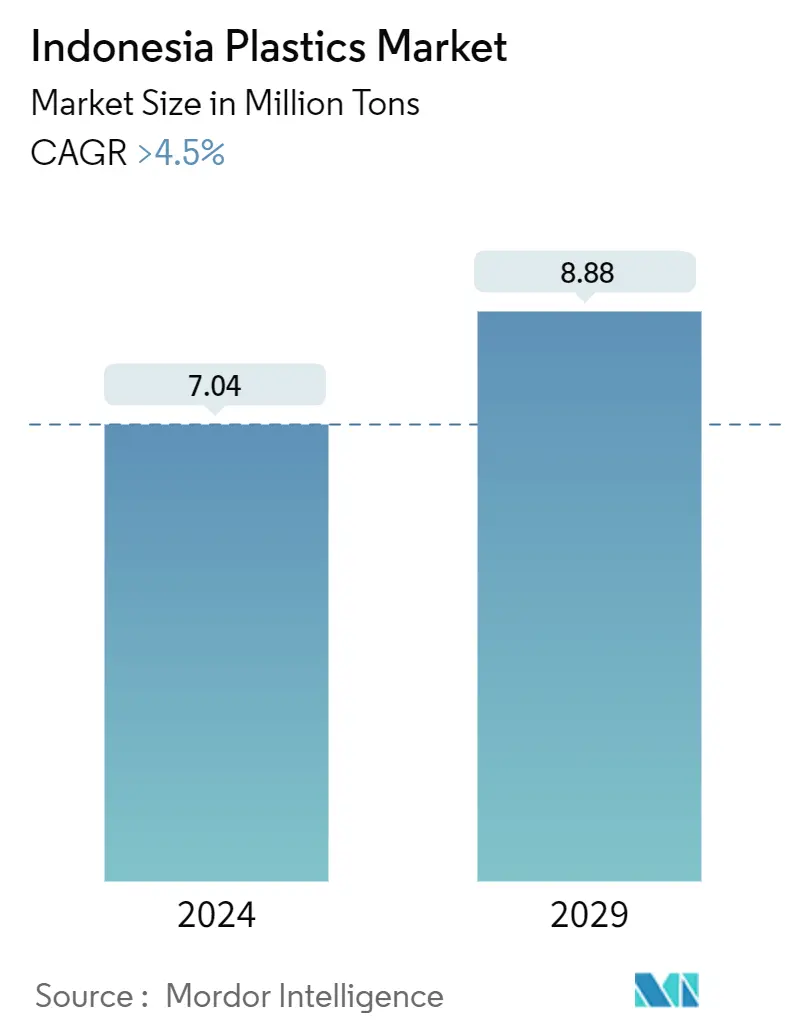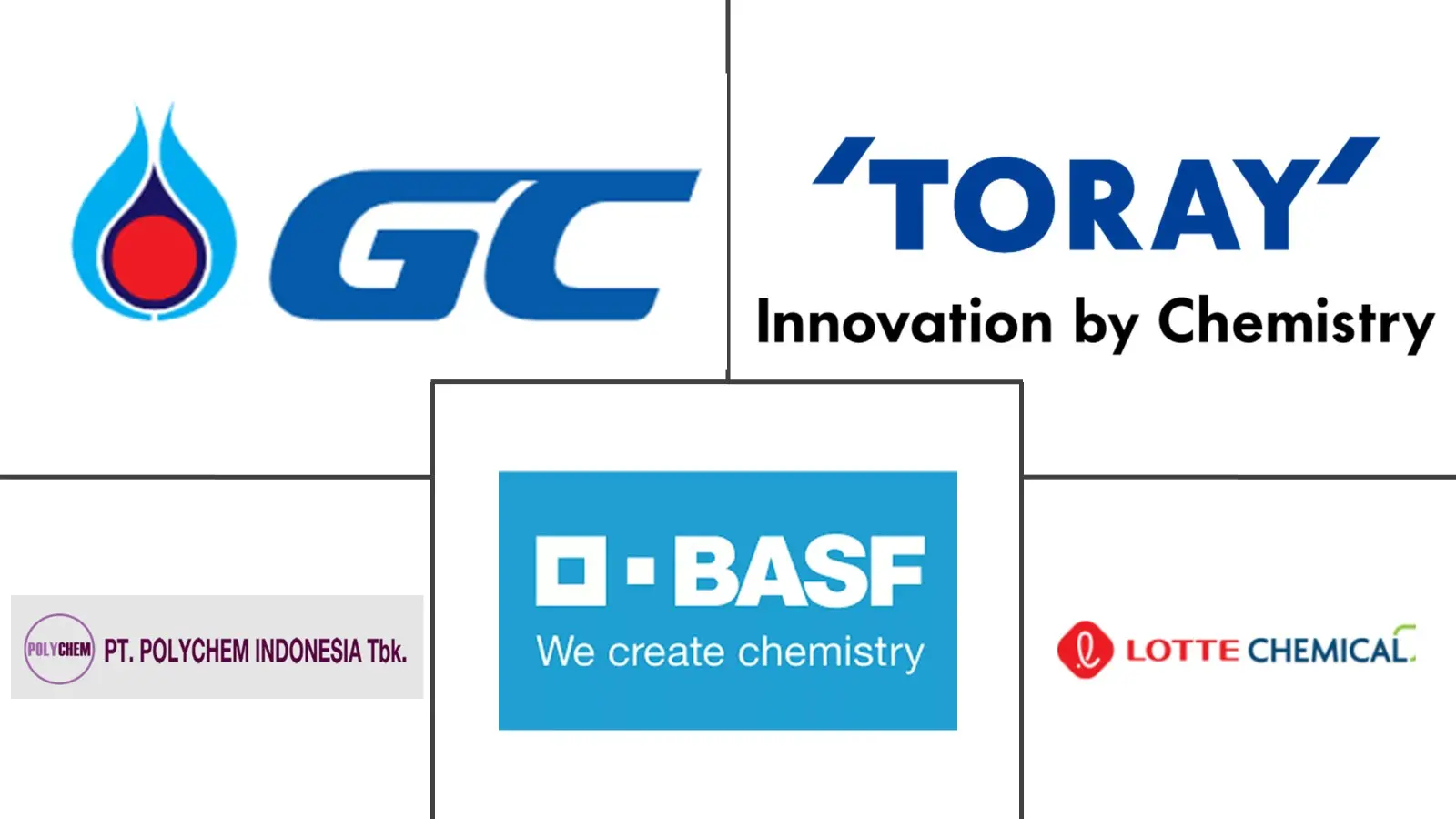Market Size of Indonesia Plastics Industry

| Study Period | 2019 - 2029 |
| Base Year For Estimation | 2023 |
| Market Volume (2024) | 7.04 Million tons |
| Market Volume (2029) | 8.88 Million tons |
| CAGR (2024 - 2029) | > 4.50 % |
| Market Concentration | High |
Major Players
*Disclaimer: Major Players sorted in no particular order |
Indonesia Plastics Market Analysis
The Indonesia Plastics Market size is estimated at 7.04 Million tons in 2024, and is expected to reach 8.88 Million tons by 2029, growing at a CAGR of greater than 4.5% during the forecast period (2024-2029).
The COVID-19 pandemic negatively impacted the country's production and supply of plastics during the lockdown. However, the demand from the packaging segment surged due to the increasing use of online food and retail e-commerce services during the pandemic. After 2020, the market improved steadily due to continuous activities within the country.
- Over the medium term, growing demand from the end-user industries, such as packaging, electrical, and electronics, as well as the construction industry, along with the rapid increase in the downstream processing capacity additions, is expected to drive the growth of the market studied.
- However, government regulations on the use of plastics and over-reliance on the imports of raw materials are the primary factors hindering the growth of the market studied.
- Nevertheless, the rising demand for eco-friendly products is expected to offer various opportunities for the growth of the market studied.
Indonesia Plastics Industry Segmentation
Plastic is an artificial substance produced from polymers, large molecules composed of repeating subunits. These polymers are commonly derived from petrochemicals, although some plastics can be made from natural materials. The distinctive feature of plastics lies in their ability to undergo deformation and take on various forms when exposed to heat or pressure.
The Indonesian plastics market is segmented by product type, technology, and application. By product type, the market is segmented into traditional plastics and engineering plastics. By technology, the market is segmented into injection molding, extrusion molding, blow molding, and other technologies (rotational molding, thermoforming, and others). By application, the market is segmented into packaging, automotive and transportation, building and construction, electrical and electronics, furniture and bedding, and other applications (houseware, medical, and others). For each segment, the market sizing and forecasts were made based on volume (tons).
| Type | |||||||||||
| |||||||||||
| |||||||||||
| Bioplastics |
| Technology | |
| Injection Molding | |
| Extrusion Molding | |
| Blow Molding | |
| Other Technologies |
| Application | |
| Packaging | |
| Electrical and Electronics | |
| Building and Construction | |
| Automotive and Transportation | |
| Furniture and Bedding | |
| Other Applications (Houseware) |
Indonesia Plastics Market Size Summary
The Indonesian plastics industry is poised for significant growth over the coming years, driven by increasing demand from various end-user sectors such as packaging, electronics, and construction. The market's recovery post-COVID-19 has been bolstered by the surge in e-commerce and online retail, which has heightened the need for packaging solutions. Despite challenges such as government regulations and reliance on imported raw materials, the market is expected to expand, supported by advancements in downstream processing capacities. The growing preference for eco-friendly products presents additional opportunities for market growth, particularly in the packaging segment where plastics like polyethylene terephthalate (PET) are favored for their durability, recyclability, and safety features.
The use of plastics in Indonesia is further amplified by their critical role in the pharmaceutical and electronics industries, where they are utilized for packaging and component manufacturing due to their lightweight and durable properties. Injection molding technology is increasingly adopted for producing complex plastic shapes, catering to the automotive and medical sectors. The market is characterized by a consolidated landscape with key players such as BASF SE and PT LOTTE CHEMICAL TITAN Tbk. Recent investments and collaborations, such as those by ExxonMobil and Toyobo, highlight the industry's focus on innovation and sustainability. These developments are expected to drive steady market growth, with significant contributions from both domestic and international players.
Indonesia Plastics Market Size - Table of Contents
-
1. MARKET DYNAMICS
-
1.1 Drivers
-
1.1.1 Growing Demand from the End-user Industries
-
1.1.2 Rapid Increase in the Downstream Processing Capacity Additions
-
1.1.3 Other Drivers
-
-
1.2 Restraints
-
1.2.1 Over-reliance on the Imports of Raw Materials
-
1.2.2 Government Regulations on the Use of Plastics
-
-
1.3 Industry Value Chain Analysis
-
1.4 Porter's Five Forces Analysis
-
1.4.1 Bargaining Power of Suppliers
-
1.4.2 Bargaining Power of Buyers
-
1.4.3 Threat of New Entrants
-
1.4.4 Threat of Substitute Products and Services
-
1.4.5 Degree of Competition
-
-
-
2. MARKET SEGMENTATION (Market Size by Volume)
-
2.1 Type
-
2.1.1 Traditional Plastics
-
2.1.1.1 Polyethylene
-
2.1.1.2 Polypropylene
-
2.1.1.3 Polyvinyl Chloride
-
2.1.1.4 Polystyrene
-
-
2.1.2 Engineering Plastics
-
2.1.2.1 Polyethylene Terephthalate (PET)
-
2.1.2.2 Polybutylene Terephthalate (PBT)
-
2.1.2.3 Polycarbonates(PC)
-
2.1.2.4 Styrene Polymers (ABS & SAN)
-
2.1.2.5 Fluoropolymers
-
2.1.2.6 Polyoxymethylene (POM)
-
2.1.2.7 Polymethyl Methacrylate (PMMA)
-
2.1.2.8 Polyamide (PA)
-
2.1.2.9 Other Engineering Plastics (Liquid Crystal Polymer, Polyether Ether Ketone)
-
-
2.1.3 Bioplastics
-
-
2.2 Technology
-
2.2.1 Injection Molding
-
2.2.2 Extrusion Molding
-
2.2.3 Blow Molding
-
2.2.4 Other Technologies
-
-
2.3 Application
-
2.3.1 Packaging
-
2.3.2 Electrical and Electronics
-
2.3.3 Building and Construction
-
2.3.4 Automotive and Transportation
-
2.3.5 Furniture and Bedding
-
2.3.6 Other Applications (Houseware)
-
-
Indonesia Plastics Market Size FAQs
How big is the Indonesia Plastics Market?
The Indonesia Plastics Market size is expected to reach 7.04 million tons in 2024 and grow at a CAGR of greater than 4.5% to reach 8.88 million tons by 2029.
What is the current Indonesia Plastics Market size?
In 2024, the Indonesia Plastics Market size is expected to reach 7.04 million tons.

